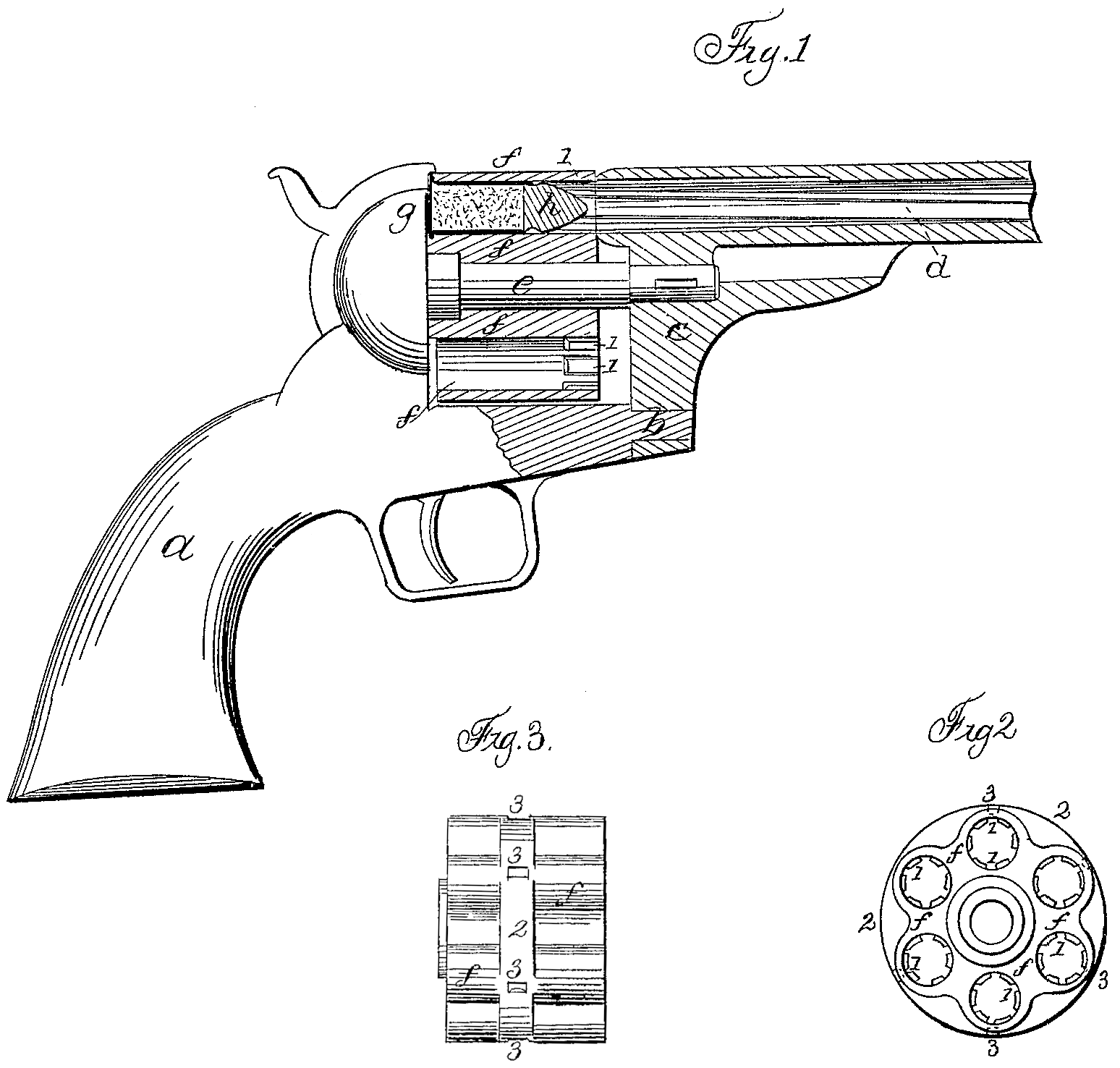US 34067
UNITED STATES PATENT OFFICE.
DANIEL MOORE, OF BROOKLYN, NEW YORK.
IMPROVEMENT IN REVOLVING FIRE-ARMS.
Specification forming part of Letters Patent No. 35,067, dated January 7, 1862.
To all whom it may concern:
Beit known that I, Daniel Moore, of Brooklyn, in the county of Kings and State of New York, have invented, made, and applied to use a certain new and useful Improvement in Revolving Fire-Arms; and I do hereby declare that the following is a full, clear, and exact description of my said invention, reference being had to the annexed drawings, making part of this specification, wherein—
Figure 1 is a vertical section of my arm, and Fig. 2 is an end view of the chambers detached.
Similar marks of reference denote the same parts.
My invention relates to that class of fire-arms in which a revolving cylinder of chambers is applied to a stationary barrel. In all the arms of this character in which a rifled barrel is employed the ball is slugged or forced into the rifle-grooves in the barrel. The ball as it is discharged from the chamber in line with the barrel meets with the obstruction and comparative detention caused by the said rifling, and the recoil of the powder acts to produce an opening between the front end of the chamber and rear of the barrel, causing escape of gases or “windage.”
The nature of my said invention consists in constructing the forward end of each chamber, which is open at the rear, with a rifled surface corresponding to the grooves in the barrel, so that the ball entered with the cartridge from the rear of the chamber is slugged previous to entering the barrel, and the explosion and the detention of the ball in being forced into the rifling cause the chamber to press firmly against the rear end of the barrel, thereby cutting off and preventing as much escape of gases as possible.
In the drawings, a is the handle or stock, of any desired shape or character. b is the metallic connection to the arm c of the rifled barrel d. e is the axis of the chambered cylinder f. There may be any desired number of chambers in this cylinder, each made exactly alike, and each chamber is open right through the cylinder. The forward part of each chamber is bored smaller than the rear in order that rifle-grooves 1 1 may be cut therein, and for this purpose the rifling-instrument may be passed through the barrel and applied to rifle each chamber in succession, or otherwise, so that the grooves of the barrel and chambers correspond when on line with each other.
The cartridge I employ is provided with a metal shell or case setting at the rear against the recoil-plate q and carrying the ball h at the forward end. This character of cartridge is well known, and it will be evident that either this cartridge or one acting in the same manner is the only one that can be employed with this improvement, as the chambers have to be open at the rear in order that the ball may be entered behind the rifling at the forward end.
When the piece is discharged the slugging of the ball is effected in the chamber, the act of doing which tends to force the chamber against the rear end of the barrel, the ball proceeds, and the force of the powder is not decreased by windage, as heretofore.
The stop lever or bolt that holds the cylinder in place, as heretofore, takes recesses in the surface of the cylinder, and to insure the correct action of said lever or bolt it is important that the said surface be cylindrical at this point; but the weight of the cylinder f is greatly increased by making the entire exterior cylindrical. I therefore recess the metal between the barrels, as seen in Figs. 2 and 3, so as to remove useless weight and leave a band or ring, 2, to receive the notches 3, that take the stop lever or bolt, and the necessary strength is maintained at the part where these notches 3 are made.
What I claim, and desire to secure by Letters Patent, is—
1. The employment, in a cylinder with chambers open at the rear, of rifling at the forward end of each chamber, corresponding with the grooves in the barrel, for the purposes, and as specified.
2. The band or ring 2, having the recesses 3 3 for the stop lever or bolt, the said ring being formed as and for the purposes specified.
In witness whereof I have hereunto set my signature this 15th day of November, 1861.
DANL. MOORE.
Witnesses:
Lemuel W. Serrell,
Thos, Geo. Harold.

